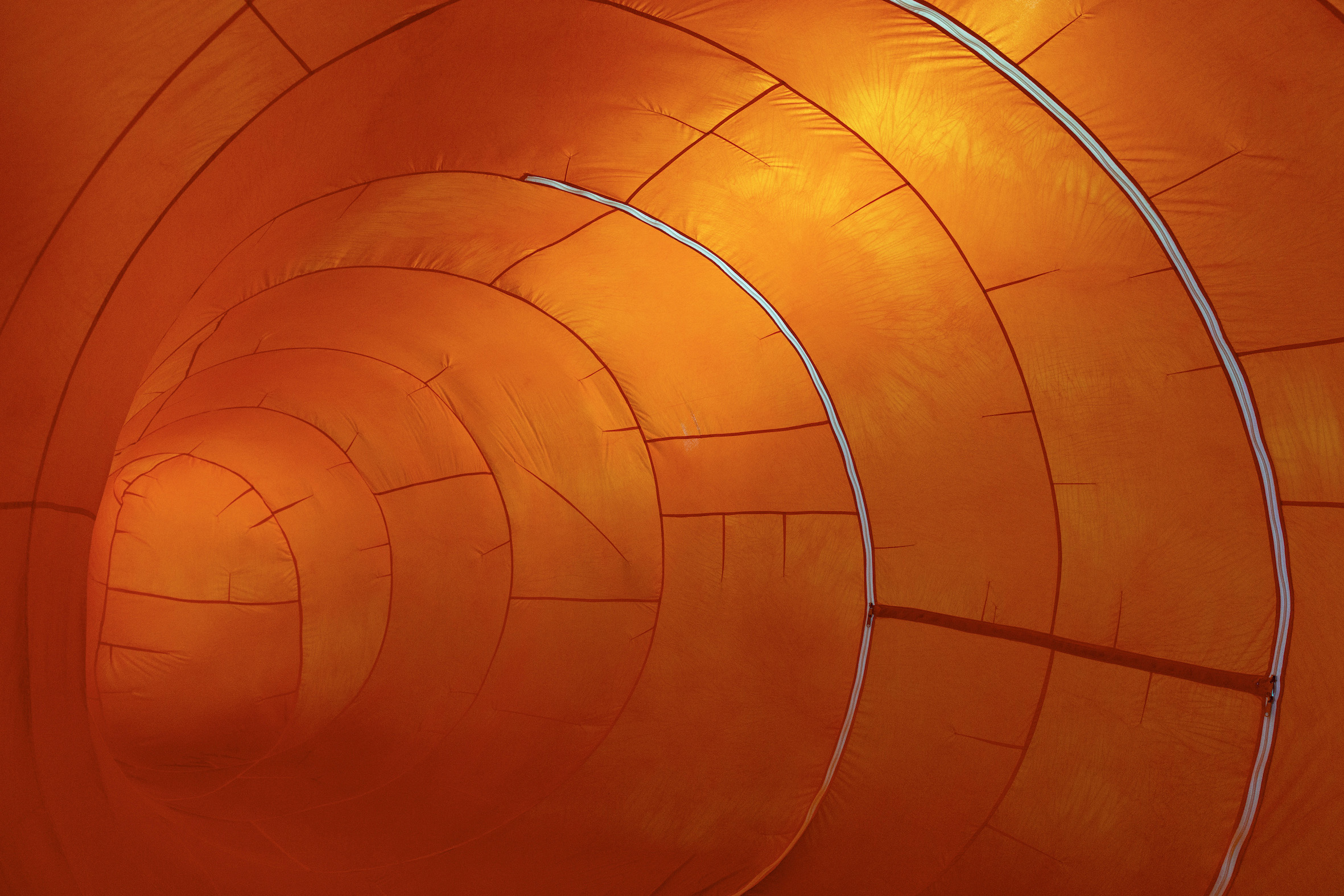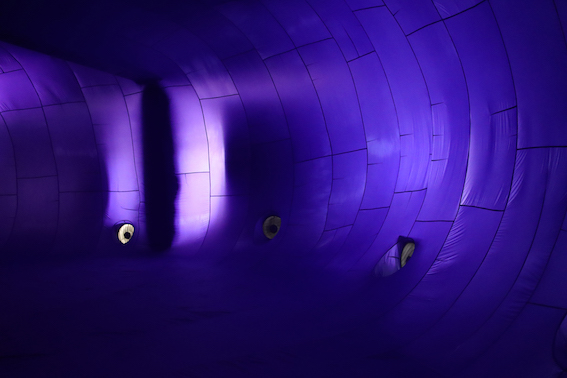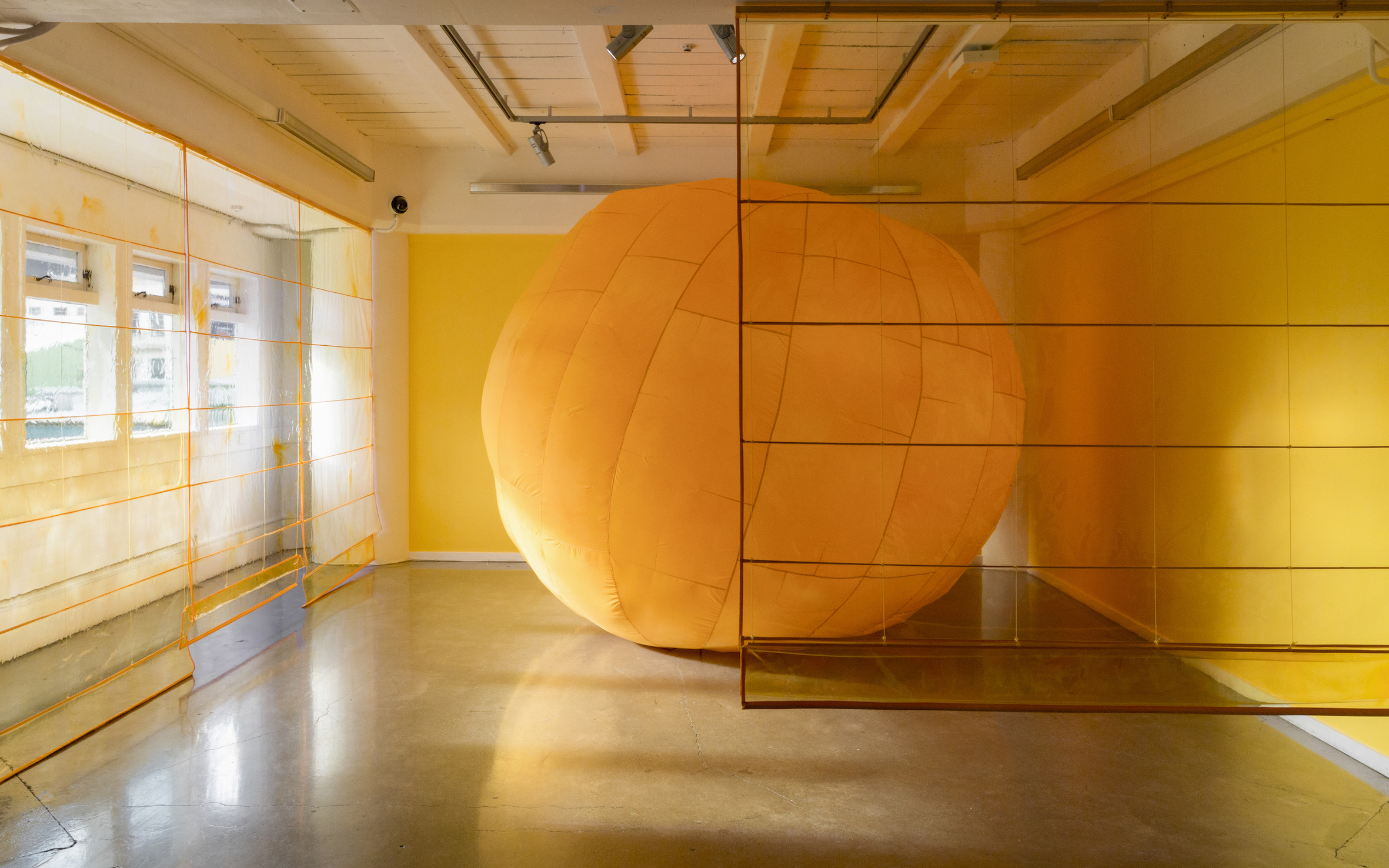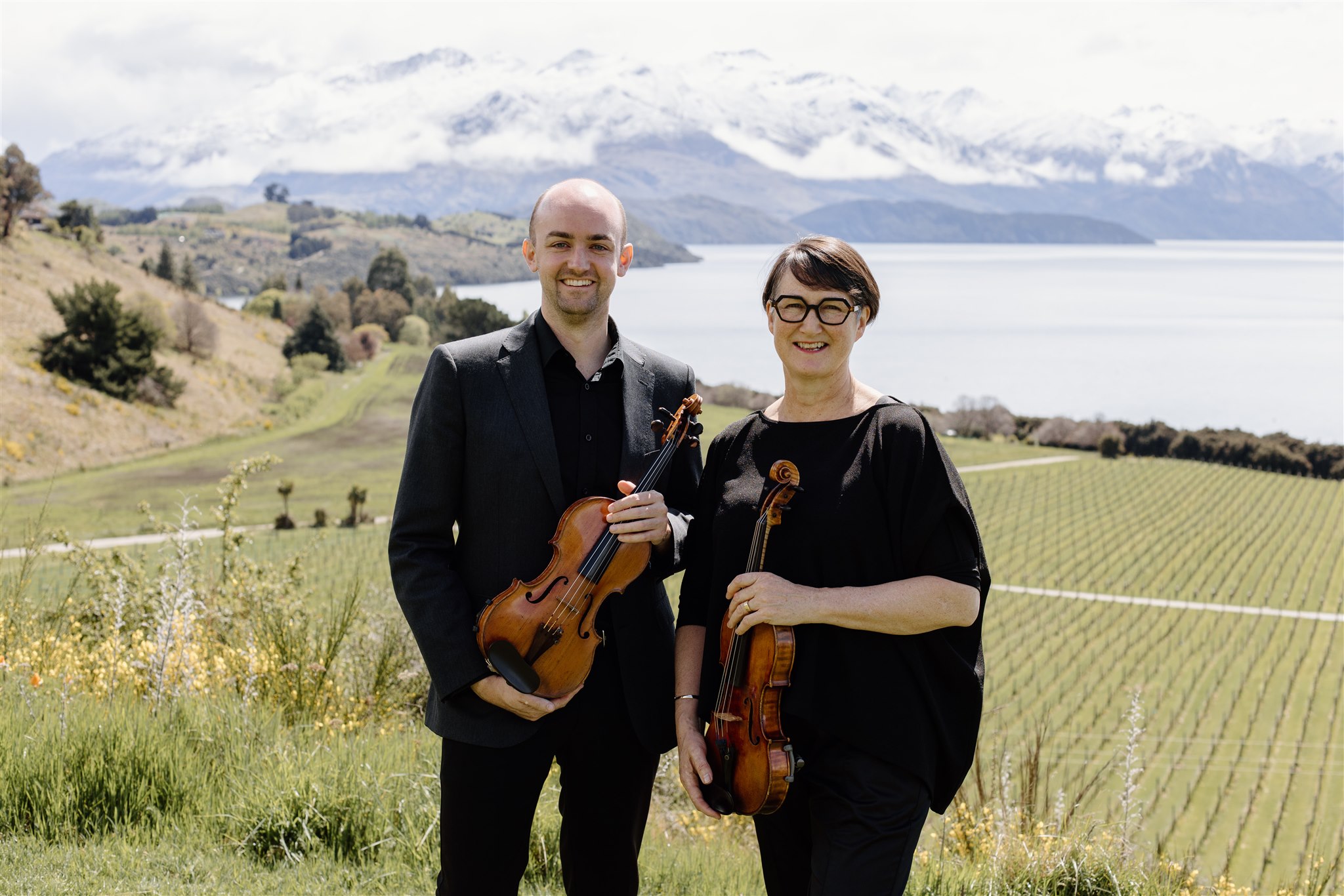Frameworks of care: Bailee Lobb

Interview with artist Bailee Lobb.
Bailee Lobb, In Bathing, Bask
16 May - 3 July 2022
The first exhibition in Te Atamira’s main gallery space – WHAKAARI – is by Wellington-based artist Bailee Lobb. In Bathing, Bask is an immersive installation of a group of large, brightly coloured inflatable sculptures – soft structures that are big enough for visitors to enter and move through or rest inside. I asked Bailee a few questions about this project in particular and her work in general.
Louise Garrett, Te Atamira arts and culture coordinator
LG: I’m interested in finding out about the basis of the creative enquiry that led to In Bathing, Bask. When did you start working with inflatable structures and what was your motivation or starting point?
BL: It started in 2018, with a particularly bad bout of insomnia. No matter what I tried I just couldn’t sleep at night, only as the first light of day broke and the earth was bathed in a beautiful yellow glow would I finally fall asleep. The work started as a desire to capture this yellow glow and create a space that I could bathe in, to relax and prepare for bed. I don’t remember making a conscious decision that the work would be inflatable, instead I was focused on it being collapsible, and fully enclosed. This led to my first inflatable prototype: a duvet-cover safety-pinned to a fan. It was rough, but it felt surprisingly light and spacious and there were some sensory benefits that I hadn’t planned on – the fan created white dulling noise, and the light coming through the fabric was muted and diffuse. It felt like it might just do what I needed so I started drafting a pattern.
I had no idea how to make inflatable forms at the time and used mathematical flat-drafting techniques to get the shape – a very different process from how I work today. The work was called -4º to 6º (the golden hour), and it was bright yellow. I loved being inside the work, and it was hugely popular in group exhibitions. I used it often at home to relax and it really helped me. I had no idea at the time that I was using it for self-regulation – that knowledge came much later. I loved the adaptability of the inflatable form – I could pop it up in any room, any time. It was light and could go on the floor, or my bed. It expanded to fill up whatever space was available, and then folded down small for easy storage.
It took me a while to understand why I needed the work so much. It was only in reflecting on the first solo exhibition Thresholds, that I understood that I was using the spaces to self-regulate. With this knowledge, In Bathing, Bask was born. Since making my first inflatable, I have made many more, developing new techniques for pattern drafting, and sewing, and working at scales that I could never have imagined when I first started out. I love sculpting air and am currently working on new ways to use inflation to create more accessible installation artworks.
LG: Colour is clearly a highly significant component in your work. Can you describe the effect of colour in the work and what it signifies for you?
BL: Colour is a very important part of my life. I grew up surrounded by colour and texture. My Mum has her interior design studio at home, and it is a treasure trove of reference books, wallpapers, fabrics, and all the colours you can think of. From her I developed an early understanding of how different colours felt to be surrounded in. Although I have always loved colour it didn’t really take hold in my practice until I had left university. Believe it or not, all through my studies I mostly used neutrals! Colour was only really taught in relation to painting, a subject that I did not take. In sculpture, performance, and installation we learnt about materials and mostly used the colour that the material was. I was using a lot of natural materials at the time so that meant a lot of cream and tan.
When I started creating immersive works, I started using a lot more colour. I was creating spaces for people to feel things in, and colour is an important element of feeling – we talk about being blue with sadness, red with anger, and green with envy. A lot of people don’t understand the impact that colour can have on them. We think and feel in colour, and yet we often choose to surround ourselves in neutrals, blankness that doesn’t make us really feel anything.
Using colour is joyous, and sometimes hard. Some colours don’t feel good to some people, but that is part of the point. In understanding what does and doesn’t feel good we clear the way for creating spaces for ourselves that are really enriching. I am quite deliberate with the colours I use. They all need to work together but there also needs to be variety so that if a colour feels terrible to someone, they can try something else. I also use colours that feel terrible to me because I know they feel good to other people – like hot pink! I apply a much more painterly lens to my practice than I did in the beginning. I layer colour through object placement and utilise natural light in exhibition spaces so that the works change throughout the day.
When I reflect on my early artworks I see so much missed opportunity for colour, but I also feel like I maybe needed to develop my understanding of materials away from colour. Colour enriches everything, and in those early days it would have been easy for me to get carried away by a colour and disregard an aspect of the material that made it unsuitable for the task. Working in neutrals meant I had to develop a stronger awareness of how the material operated, and what it offered. It was good groundwork for adding colour later, which is still how I operate. Most of my materials start out white – I hand dye and custom colour everything so that it reflects my vision. I wouldn’t be able to do this if I didn’t have a strong understanding of the properties of my materials.
LG: You are also involved in performance work and In Bathing, Bask is in some ways an installation that encourages the audience to ‘perform’ or interact with the work in particular ways. How did you start out in the live art area? Can you tell me about your practice in relation to performance?
BL: The body has always been a really important element of my practice – my body and the visiting body. I naturally lean towards gentle movement, the flow of a river around my feet, dancing to music, the wind on my skin, stretching out stillness. I explore the world with my body, and this can make it hard to not touch things in a gallery: I find it difficult to engage with artwork that I can’t interact with. I have an easier time with craft work, as I can more readily imagine how a textile might feel due to my craft-oriented upbringing. My practice reflects this: I use mostly craft-based materials that the audience can touch and my work is quite performative. My installation works move through interaction, and my video and performance work generally focuses on gentle or small movements.
I didn’t really know much about performance art before I went to art school. I had had a bit of exposure to immersive installation work, but most of the art I grew up seeing in galleries fell into the ‘do not touch’ category. The discovery of relational aesthetics,* participatory art, and performance were huge revelations – to express an idea with your body, to explore materials that way was very natural to me. I engaged first with making participatory works: works that didn’t work unless you interacted with them and at this time, I was using my body to test them to understand what they were communicating. I was interested in performance art but hadn’t quite taken the leap. Then, I was approached by Amy Claire Mills and Kate Bobis about starting a performance artist collective. Show Us Your Teeth was formed in 2014, during my second year of university. In the beginning we only did performance work. We have since branched out into installation and participatory art but always centred around the body. Once I became comfortable with performance, I incorporated more of it into my solo practice. My performance work tends to be fairly pared back in comparison to the rest of my practice. The focus is on the body and the way it moves. My costumes are neutral, and the works are slow, meditative.
The performance art I make with Show Us Your Teeth is completely different than my solo work, it tends to be a bit more absurd, with elaborate costumes, and it reflects the three of us as a group. I love working collaboratively with other amazing artists: it's challenging in different ways than working solo and it gives me an outlet for ideas that are adjacent to my central practice themes.
LG: You first showed In Bathing, Bask at Toi Pōneke in Wellington last year. Tell me about the audience’s response to the work. What are some of the ways that visitors interacted with the work? Were there any unexpected responses?
BL: The response to my work was amazing! I had visitors from all parts of the community, and many of them came back more than once.Visitors who came alone generally spent more time in the gallery than those in groups, often up to an hour just immersing themselves in the work. These visitors generally either responded by going very quiet, and calm, or by moving – we had some dancing, a fair bit of vocal stimming,** and a lot of gentle stretching. These responses usually varied across the spaces, as the visitor responded to the colour. For groups, it varied wildly depending on the makeup of the group: some groups were in and out and full of play, while others were quite serious and had conversations about how each of the colours made them feel. It was amazing to see young children engaging with the works and talking about how each space felt for them. Conversations like these are part of the reason I make public work that is accessible to everyone – if we can start these conversations early then kids will learn how to create spaces around them that help them self-regulate. In our increasingly chaotic world, we can all benefit from having spaces that nurture and soothe us in the way that we need.
In terms of surprises, the gallery staff got a few! When I did my pre-opening safety briefing, they thought I was joking when I asked that they open and look inside each work before locking up at the end of the day, but I wasn’t. More than once a very relaxed visitor was found inside a work, with no idea that the staff were locking up. They were generally so immersed in the work that they had lost all track of time. I really relate to this type of visitor because if I stumbled across these works on my way home from work one night, that would be me – still in them at close!
LG: You have described your high degree of sensory sensitivity and you also identify as neurodivergent. Can you say something about your disabilities and whether they influence your artistic practice?
BL: My disabilities influence every part of my artistic practice. They affect my flow in the studio and are my primary subject matter: all my work either relates to the framework of care or to making visible an experience of disability that is otherwise unseen. My disabilities mostly aren’t visible to others, but they have a huge impact on my experience of the world. In addition to being chronically overstimulated, I experience chronic pain, migraines, executive dysfunction, thermal dysregulation and other ‘hard to describe’ symptoms. I think of art as a communication tool, and it is amazing for beginning to get at these ‘hard to describe’ experiences. If you have never felt hot when everyone else was cold, or had a heavy day how do you know what that feels like? A huge part of the reason I create immersive work is because sometimes you need to experience something first hand to start to understand it. Invisible disability is one of those things. It can be hard for people to wrap their heads around the idea that someone who looks just like them might experience the world in a completely different way.
My practice helps me figure things out too. In Bathing, Bask is part of a framework of care: these objects are an expression of care for myself, an extension of my day-to-day toolkit for self-regulation. All my life, I have sought out quiet, dimly lit, hiding spaces to escape to – I didn’t realise I needed the spaces for self-regulation. I can be slow to process things, so I use reflection and iterative making in my practice to build understanding over time. Reflecting on my own experience inside -4ºto 6º (the golden hour) was how I figured out that the space functioned as a tool for self-regulation. I didn’t have the language at the time, but it made me seek out people with the same experiences as me, and that’s how I worked out that I was neurodivergent.
Community is so important with any kind of disability or difference. As someone whose brain works a bit differently, I spend a lot of time doing mental gymnastics so I can keep up with conversations and not miss things. I do this while also trying to ignore every sound in the neighbourhood and pretending that I am not in pain, that that light is not bothering me, and that I feel fine. This is called masking and it’s super common in both disabled and neurodivergent people. One of the best things about finding community is that you can let go of that mask. During my artist talk at Toi Pōneke, I was thrilled to find out that most of the audience either was neurodivergent themselves or had a kid/friend who was. Most were drawn to the talk because sensory overload and stimming is central to In Bathing, Bask and they knew it would be part of the conversation. We had an amazing mask-free discussion about my work, living in a neuro-typical world, coping mechanisms, and what we wanted to see more of in the future. It was awesome!
LG: Besides the project at Te Atamira, what are you working on at the moment?
BL: I am in the beginning stages of a new body of work that uses knitting to explore my experience of the visual disturbance 'visual snow'. I see multi-coloured snow (static) over my vision, experience strong after-images from high contrast surfaces and have poor night vision. I have had this snow my whole life, but it is stronger at times. It can be distracting, tiring, and sometimes nausea inducing: the world I see is grainy, and constantly in motion. The idea to explore visual snow through knitting first came to me when I was knitting a mohair jumper. The pattern called for two strands of mohair to be held double. I had trouble finding the right blue and so chose two different coloured mohair strands that when combined created the blue I wanted. The result was a jumper that from afar was one perfect colour, but that up close was a bespeckled, grainy mix of the two colours: just like my visual snow, only fewer colours. I had been wanting to incorporate knitting into my practice for some time as it is a useful stim for me, so I was immediately excited by this discovery.
Since then, I have started sampling, creating small, knitted paintings using photographs as the base image. In the first one I primarily used the knitting gauge to create the grainy image, and in the second one I am incorporating striped dying, and mohair to create more movement in the knitted image. These samples are helping me to improve my knitting and dying techniques, as well as helping me to figure out the best subject matter for me. I am knitting with sometimes 20+ colours at a time: it is complicated and it's new to me, so I am taking my time to explore the technique before committing to a larger piece. It’s not quite as stimmy for me yet as standard knitting is as it requires a lot more focus than one colour but I think it will get there.




LG: What would be your dream project?
BL: I love this question because it used to be In Bathing, Bask! I dreamt it up when travelling in Ireland, and when I proposed it for Toi Pōneke I honestly never thought I would get the exhibition, so I went all in – proposed my dream. When I got the exhibition, my reaction was probably one part excitement and two parts panic that I had to make the work. The exhibition had a lot of development built in and it has really pushed me as an artist. Dreams are an excellent way to grow as an artist and I believe in dreaming big, especially when it comes to scale!
Lately, I have been dreaming about supportive sleep structures. It’s a project based on supporting the body in different positions at rest, for optimal sleep while in pain. I often find standard beds uncomfortable because they are so flat that they accommodate a limited number of sleep positions – you can add a few more with cushions but it’s far from ideal. In my head I envisage a room full of sculptures for sleeping in – beds shaped by body position, so your feet hang freely, or your legs are held at 45º angles to your body. Each of these beds would be upholstered in soft textiles, with knitted pyjamas in matching colours. I will perform as part of the exhibition, taking naps in each of the beds.
This is a dream that needs quite a bit of space as the beds won’t flatpack like my inflatables do. Lots of space is not something I have available to me at the moment, but I have started working on knitting patterns for the pyjamas…
*Relational aesthetics is a term coined by French curator Nicholas Bourriaud in the 1990s. It refers to forms of art that activate and foreground human relations and their social context, ie. art embedded in social environments rather than being an object distinct from everyday life. In the frame of relational aesthetics, the artist and the artwork are considered as conduits for social experience.
**Stimming refers to self-stimulating behaviours, usually involving repetitive movements or sounds. Everybody stims in some way. Stimming is associated with managing emotions, maintaining calm and dealing with overwhelming situations.
Click here for more information about Bailee Lobb's exhibition In Bathing, Bask at Te Atamira.





.png)

